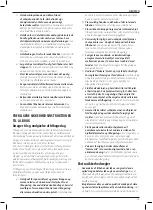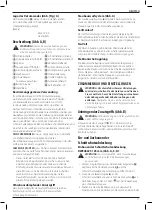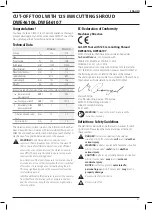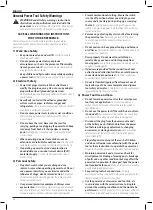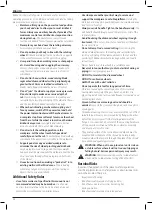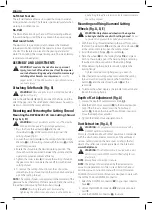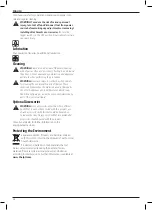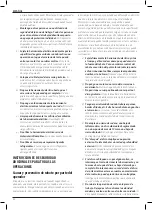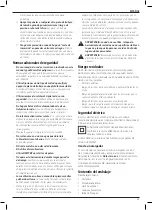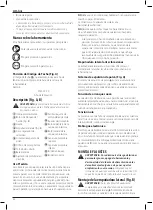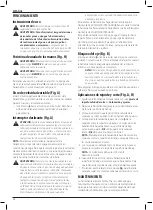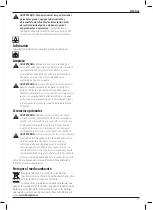
24
EngLIsh
•
Use clamps or another practical way to secure and
support the workpiece to a stable platform.
Holding the
work by hand or against your body leaves it unstable and may
lead to loss of control.
•
Always use side handle. Tighten the handle securely.
The
side handle should always be used to maintain control of the
tool at all times.
•
Avoid bouncing the diamond wheel or giving it rough
treatment.
If this occurs, stop the tool and inspect the wheel
for cracks or flaws.
•
Do not attempt to do curved cutting.
Overstressing the
diamond wheel increases the loading and susceptibility to
twisting or binding of the diamond wheel in the cut and the
possibility of kickback or wheel breakage, which can lead to
serious injury.
• Always handle and store wheels in a careful manner.
•
Never cut into area that may contain electrical wiring or
piping.
Serious injury may result.
•
DO NOT cut metal with a diamond wheel.
•
DO NOT use abrasive wheels.
•
ALWAYS use with a dust collector.
•
Do not operate this tool for long periods of time.
Vibration caused by the operating action of this tool may
cause permanent injury to fingers, hands, and arms. Use
gloves to provide extra cushion, take frequent rest periods, and
limit daily time of use.
•
Air vents often cover moving parts and should be
avoided.
Loose clothes, jewelry or long hair can be caught in
moving parts.
• Threaded mounting of accessories must match the cut-off tool
spindle thread. For accessories mounted by flanges, the arbor
hole of the accessory must fit the locating diameter of the
flange. Accessories that do not match the mounting hardware
of the power tool will run out of balance, vibrate excessively
and may cause loss of control.
• The grinding surface of the centre depressed wheels must be
mounted below the plane of the shroud lip. An improperly
mounted wheel that projects through the plane of the shroud
lip cannot be adequately protected.
WARNING: When not in use, place tool on its side on
a stable surface where it will not cause a tripping or
falling hazard. Serious personal injury may result.
WARNING:
We recommend the use of a residual current
device with a residual current rating of 30mA or less.
Residual Risks
In spite of the application of the relevant safety regulations
and the implementation of safety devices, certain residual risks
cannot be avoided. These are:
• Impairment of hearing.
• Risk of personal injury due to flying particles.
• Risk of burns due to accessories becoming hot
during operation.
• Risk of personal injury due to prolonged use.
Kickback is the result of power tool misuse and/or incorrect
operating procedures or conditions and can be avoided by taking
proper precautions as given below:
a )
Maintain a firm grip on the power tool and position
your body and arm to allow you to resist kickback
forces. Always use auxiliary handle, if provided, for
maximum control over kickback or torque reaction
during start-up.
The operator can control torque
reaction or kickback forces, if proper precautions are taken.
b )
Never place your hand near the rotating accessory.
Accessory may kickback over your hand.
c )
Do not position your body in line with the rotating
wheel.
Kickback will propel the tool in direction opposite
to the wheel’s movement at the point of snagging.
d )
Use special care when working corners, sharp edges
etc. Avoid bouncing and snagging the accessory.
Corners, sharp edges or bouncing have a tendency to
snag the rotating accessory and cause loss of control
or kickback.
e )
Do not attach a saw chain, woodcarving blade,
segmented diamond wheel with a peripheral gap
greater than 10 mm or toothed saw blade.
Such
blades create frequent kickback and loss of control.
f )
Do not “jam” the wheel or apply excessive pressure.
Do not attempt to make an excessive depth of
cut.
Overstressing the wheel increases the loading and
susceptibility to twisting or binding of the wheel in the cut
and the possibility of kickback or wheel breakage.
g )
When wheel is binding or when interrupting a cut
for any reason, switch off the power tool and hold
the power tool motionless until the wheel comes to
a complete stop. Never attempt to remove the wheel
from the cut while the wheel is in motion otherwise
kickback may occur.
Investigate and take corrective
action to eliminate the cause of wheel binding.
h )
Do not restart the cutting operation in the
workpiece. Let the wheel reach full speed and
carefully re-enter the cut.
The wheel may bind, walk up
or kickback if the power tool is restarted in the workpiece.
i )
Support panels or any oversized workpiece to
minimize the risk of wheel pinching and kickback.
Large workpieces tend to sag under their own weight.
Supports must be placed under the workpiece near the line
of cut and near the edge of the workpiece on both sides
of the wheel.
j )
Use extra caution when making a “pocket cut” into
existing walls or other blind areas.
The protruding
wheel may cut gas or water pipes, electrical wiring or
objects that can cause kickback.
Additional Safety Rules
•
Use of accessories not specified in this manual is not
recommended and may be hazardous.
Use of power
boosters that would cause the tool to be driven at speeds
greater than its rated speed constitutes misuse.
Summary of Contents for DWE46106
Page 1: ...DWE46106 DWE46107 Final Page size A5 148mm x 210mm ...
Page 3: ...1 Fig A 6 5 1 13 8 7 12 14 11 9 15 16 12 10 18 17 3 XXXX XX XX 19 XXXX XX XX 19 ...
Page 4: ...2 Fig D Fig E Fig B Fig C 4 2 20 8 21 18 3 24 17 ...
Page 5: ...3 Fig H Fig F Fig G 23 22 7 25 12 9 26 12 9 4 ...
Page 118: ......
Page 119: ......






